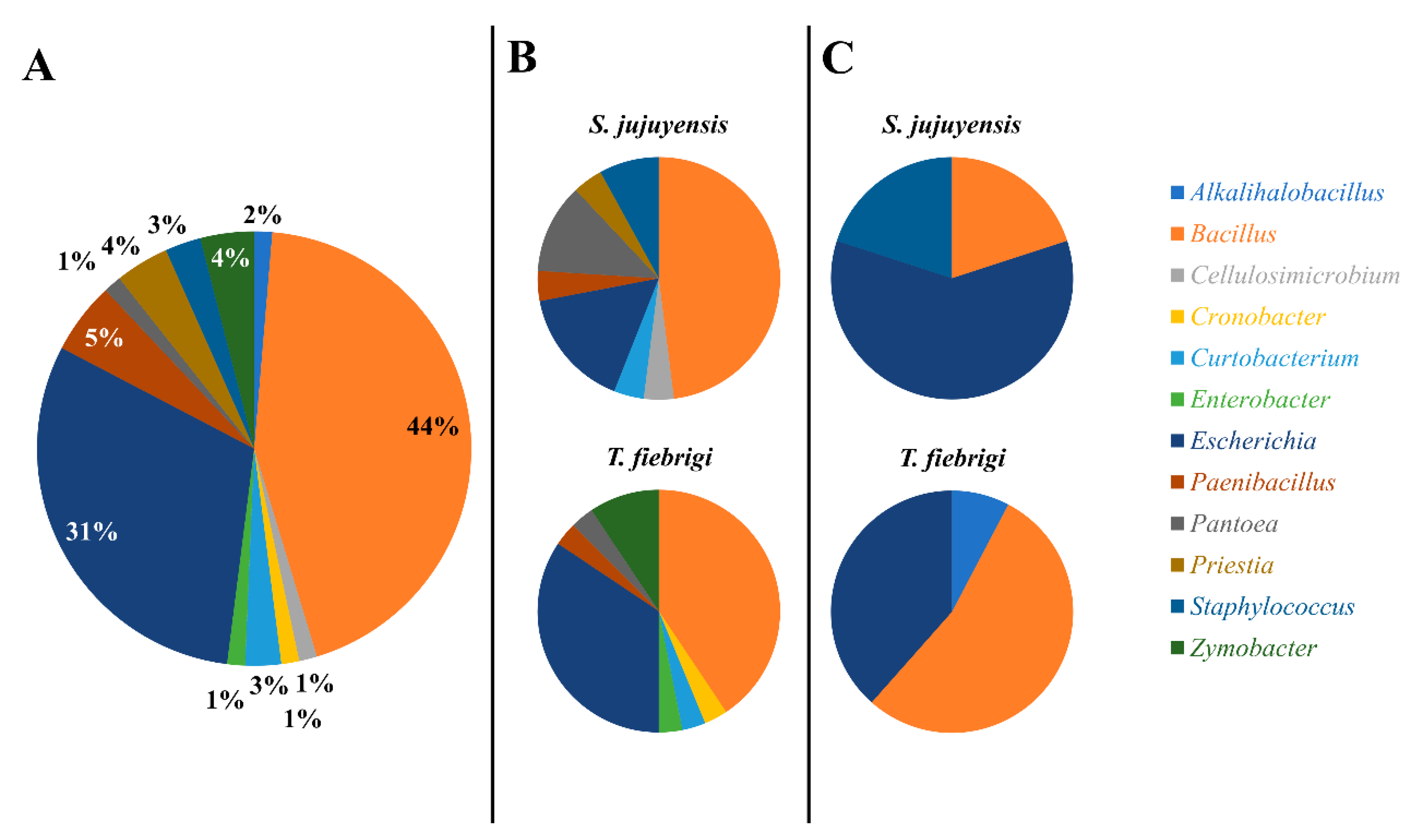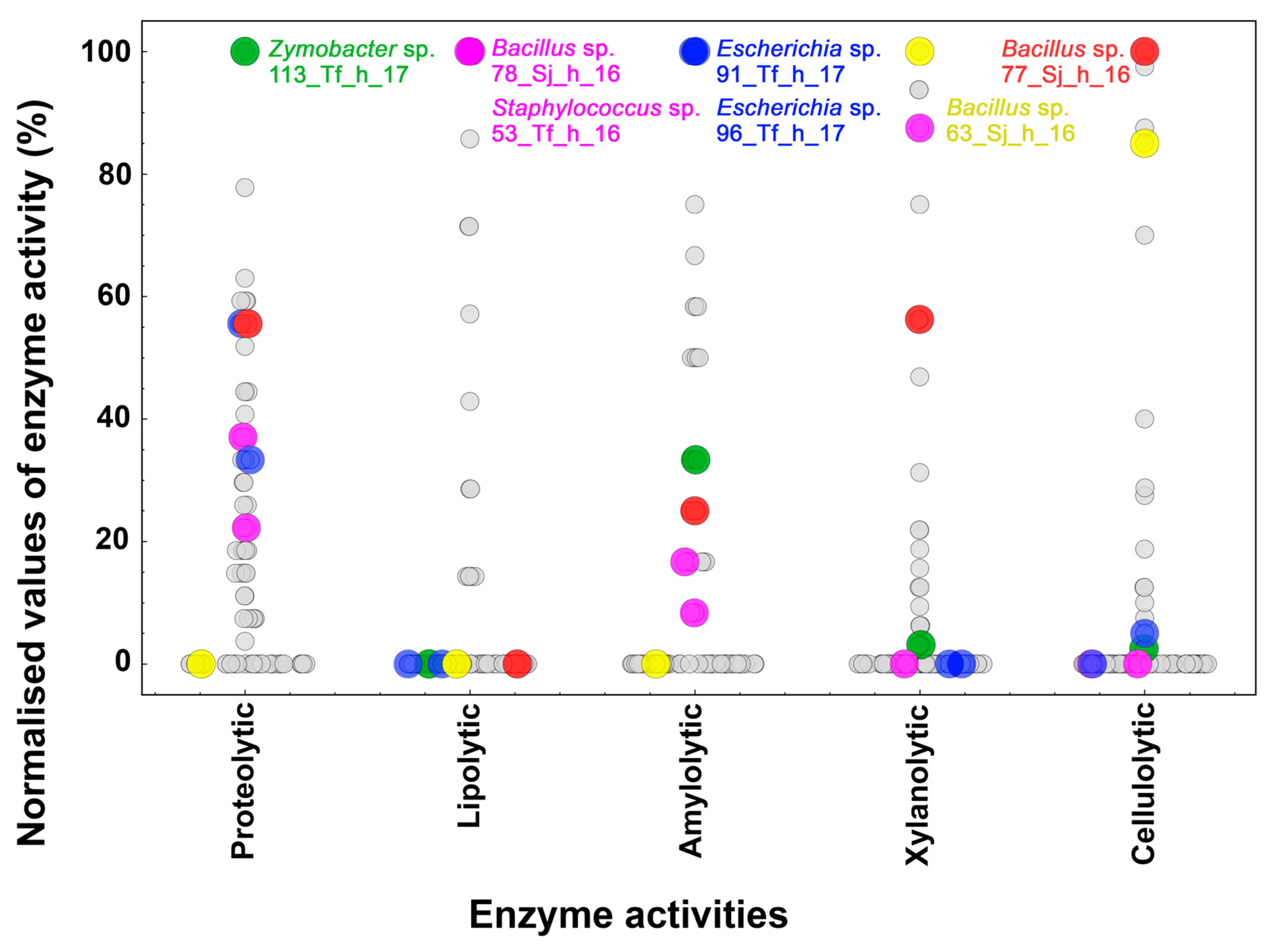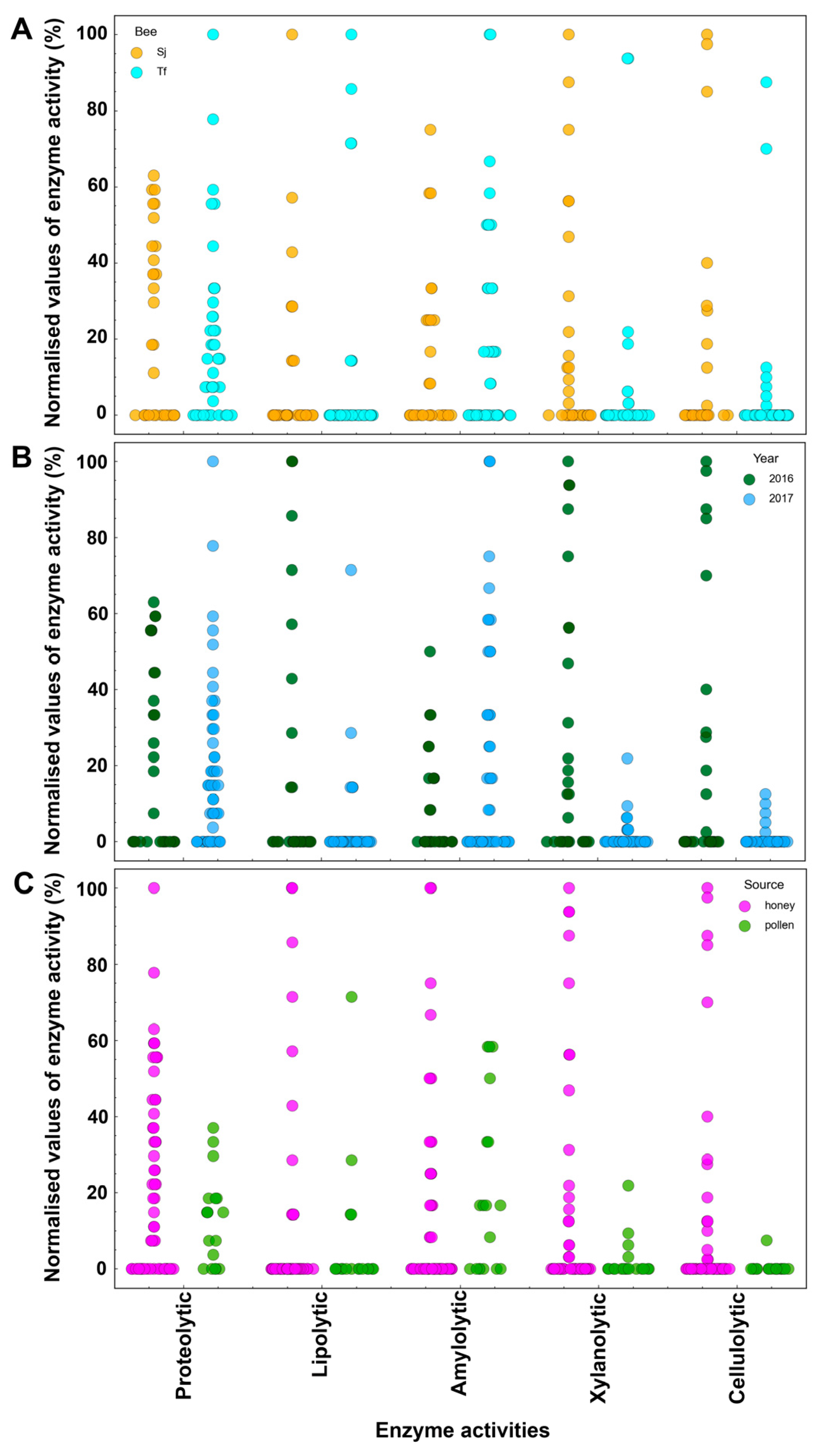Microbiological Diversity and Associated Enzymatic Activities in Honey and Pollen from Stingless Bees from Northern Argentina
Abstract
1. Introduction
2. Materials and Methods
2.1. Sampling of Honey and Pollen
2.2. Isolation and Conservation of Microorganisms
2.3. Microbiological Quality
2.4. DNA Isolation and 16S rRNA Gene Amplification of Microorganisms
2.5. Phylogenetic Analysis
2.6. Semiquantitative Determination of Enzymatic Activities
2.7. Hierarchical Analysis of Enzyme Activities of Isolated Microorganisms
2.8. Statistical Analysis
3. Results and Discussion
3.1. Microbiological Quality Analysis of Honey and Pollen
3.2. Microorganism DNA Isolation from Honey and Pollen of Stingless Bees
3.3. Enzymatic Activities of Isolated Microorganisms
4. Conclusions
Supplementary Materials
Author Contributions
Funding
Data Availability Statement
Conflicts of Interest
References
- Grüter, C. Stingless Bees: An Overview. In Stingless Bees. Fascinating Life Sciences; Springer: Cham, Switzerland, 2020; pp. 1–42. [Google Scholar]
- Salomón, V.M.; Gianni De Carvalho, K.; Arroyo, F.; Maldonado, L.M.; Gennari, G.; Vera, N.; Romero, C.M. Biopolymer Production by Bacteria Isolated from Native Stingless Bee Honey, Scaptotrigona Jujuyensis. Food Biosci. 2021, 42, 101077. [Google Scholar] [CrossRef]
- Roig-Alsina, A.; Vossler, F.G.; Gennari, G.P. Stingless Bees in Argentina. In Pot-Honey; Springer: New York, NY, USA, 2013; pp. 125–134. [Google Scholar]
- Cambronero-Heinrichs, J.C.; Matarrita-Carranza, B.; Murillo-Cruz, C.; Araya-Valverde, E.; Chavarría, M.; Pinto-Tomás, A.A. Phylogenetic Analyses of Antibiotic-Producing Streptomyces Sp. Isolates Obtained from the Stingless-Bee Tetragonisca Angustula (Apidae: Meliponini). Microbiology 2019, 165, 292–301. [Google Scholar] [CrossRef] [PubMed]
- Chuttong, B.; Chanbang, Y.; Sringarm, K.; Burgett, M. Physicochemical Profiles of Stingless Bee (Apidae: Meliponini) Honey from South East Asia (Thailand). Food Chem. 2016, 192, 149–155. [Google Scholar] [CrossRef]
- Vit, P.; d’Albore, G.R. Melissopalynology for Stingless Bees (Apidae: Meliponinae) from Venezuela. J. Apic. Res. 1994, 33, 145–154. [Google Scholar] [CrossRef]
- Esa, N.E.F.; Ansari, M.N.M.; Razak, S.I.A.; Ismail, N.I.; Jusoh, N.; Zawawi, N.A.; Jamaludin, M.I.; Sagadevan, S.; Nayan, N.H.M. A Review on Recent Progress of Stingless Bee Honey and Its Hydrogel-Based Compound for Wound Care Management. Molecules 2022, 27, 3080. [Google Scholar] [CrossRef] [PubMed]
- Majid, M.; Ellulu, M.S.; Abu Bakar, M.F. Melissopalynological Study, Phenolic Compounds, and Antioxidant Properties of Heterotrigona Itama Honey from Johor, Malaysia. Scientifica 2020, 2020, 2529592. [Google Scholar] [CrossRef]
- Biluca, F.C.; da Silva, B.; Caon, T.; Mohr, E.T.B.; Vieira, G.N.; Gonzaga, L.V.; Vitali, L.; Micke, G.; Fett, R.; Dalmarco, E.M.; et al. Investigation of Phenolic Compounds, Antioxidant and Anti-Inflammatory Activities in Stingless Bee Honey (Meliponinae). Food Res. Int. 2020, 129, 108756. [Google Scholar] [CrossRef]
- Badrulhisham, N.S.R.; Ab Hamid, S.N.P.; Ismail, M.A.H.; Yong, Y.K.; Muhamad Zakuan, N.; Harith, H.H.; Saidi, H.I.; Nurdin, A. Harvested Locations Influence the Total Phenolic Content, Antioxidant Levels, Cytotoxic, and Anti-Inflammatory Activities of Stingless Bee Honey. J. Asia Pac. Entomol. 2020, 23, 950–956. [Google Scholar] [CrossRef]
- Ávila, S.; Beux, M.R.; Ribani, R.H.; Zambiazi, R.C. Stingless Bee Honey: Quality Parameters, Bioactive Compounds, Health-Promotion Properties and Modification Detection Strategies. Trends Food Sci. Technol. 2018, 81, 37–50. [Google Scholar] [CrossRef]
- Alvarez-Suarez, J.M.; Giampieri, F.; Brenciani, A.; Mazzoni, L.; Gasparrini, M.; González-Paramás, A.M.; Santos-Buelga, C.; Morroni, G.; Simoni, S.; Forbes-Hernández, T.Y.; et al. Apis Mellifera vs Melipona Beecheii Cuban Polifloral Honeys: A Comparison Based on Their Physicochemical Parameters, Chemical Composition and Biological Properties. LWT 2018, 87, 272–279. [Google Scholar] [CrossRef]
- de Sousa, J.M.B.; de Souza, E.L.; Marques, G.; Benassi, M.d.T.; Gullón, B.; Pintado, M.M.; Magnani, M. Sugar Profile, Physicochemical and Sensory Aspects of Monofloral Honeys Produced by Different Stingless Bee Species in Brazilian Semi-Arid Region. LWT - Food Sci. Technol. 2016, 65, 645–651. [Google Scholar] [CrossRef]
- Souza, E.C.A.; Menezes, C.; Flach, A. Stingless Bee Honey (Hymenoptera, Apidae, Meliponini): A Review of Quality Control, Chemical Profile, and Biological Potential. Apidologie 2021, 52, 113–132. [Google Scholar] [CrossRef]
- Finola, M.S.; Lasagno, M.C.; Marioli, J.M. Microbiological and Chemical Characterization of Honeys from Central Argentina. Food Chem. 2007, 100, 1649–1653. [Google Scholar] [CrossRef]
- Pomastowski, P.; Złoch, M.; Rodzik, A.; Ligor, M.; Kostrzewa, M.; Buszewski, B. Analysis of Bacteria Associated with Honeys of Different Geographical and Botanical Origin Using Two Different Identification Approaches: MALDI-TOF MS and 16S RDNA PCR Technique. PLoS ONE 2019, 14, e0217078. [Google Scholar] [CrossRef] [PubMed]
- Pucciarelli, A.B.; Schapovaloff, M.E.; Kummritz, S.K.; Señuk, I.A.; Brumovsky, L.A.; Dallagnol, A.M. Microbiological and Physicochemical Analysis of Yateí (Tetragonisca Angustula) Honey for Assessing Quality Standards and Commercialization. Rev. Argent. Microbiol. 2014, 46, 325–332. [Google Scholar] [CrossRef] [PubMed]
- Hall, M.A.; Brettell, L.E.; Liu, H.; Nacko, S.; Spooner-Hart, R.; Riegler, M.; Cook, J.M. Temporal Changes in the Microbiome of Stingless Bee Foragers Following Colony Relocation. FEMS Microbiol. Ecol. 2020, 97, fiaa236. [Google Scholar] [CrossRef]
- Koch, H.; Abrol, D.P.; Li, J.; Schmid-Hempel, P. Diversity and Evolutionary Patterns of Bacterial Gut Associates of Corbiculate Bees. Mol. Ecol. 2013, 22, 2028–2044. [Google Scholar] [CrossRef] [PubMed]
- Menezes, C.; Vollet-Neto, A.; Contrera, F.A.F.L.; Venturieri, G.C.; Imperatriz-Fonseca, V.L. The Role of Useful Microorganisms to Stingless Bees and Stingless Beekeeping. In Pot-Honey: A Legacy of Stingless Bees; Springer Science & Business Media: New York, NY, USA, 2013; pp. 153–171. ISBN 9781461449607. [Google Scholar] [CrossRef]
- ISO 4831:2006; Microbiology of Food and Animal Feeding Stuffs—Horizontal Method for the Detection and Enumeration of Coli-forms—Most Probable Number Technique. ISO: Geneva, Switzerland, 2006.
- ISO 21527:2008; Microbiology of Food and Animal Feeding Stuffs Horizontal Method for the Enumeration of Yeasts and Moulds. ISO: Geneva, Switzerland, 2008.
- APHA 1992 ISO; Compendium of Methods for the Microbiological Examination of Foods, 3rd Edition. ISO, American Public Health Association: Washington DC, USA, 1992.
- Woese, C.R.; Magrum, L.J.; Gupta, R.; Siegel, R.B.; Stahl, D.A.; Kop, J.; Crawford, N.; Brosius, R.; Gutell, R.; Hogan, J.J.; et al. Secondary Structure Model for Bacterial 16S Ribosomal RNA: Phylogenetic, Enzymatic and Chemical Evidence. Nucleic Acids Res. 1980, 8, 2275–2294. [Google Scholar] [CrossRef] [PubMed]
- Manfredi, A.P.; Perotti, N.I.; Martínez, M.A. Cellulose Degrading Bacteria Isolated from Industrial Samples and the Gut of Native Insects from Northwest of Argentina. J. Basic Microbiol. 2015, 55, 1384–1393. [Google Scholar] [CrossRef]
- Bejerman, N.; Nome, C.; Giolitti, F.; Kitajima, E.; de Breuil, S.; Pérez Fernández, J.; Basigalup, D.; Cornacchione, M.; Lenardon, S. First Report of a Rhabdovirus Infecting Alfalfa in Argentina. Plant Dis. 2011, 95, 771. [Google Scholar] [CrossRef]
- Kim, O.S.; Cho, Y.J.; Lee, K.; Yoon, S.H.; Kim, M.; Na, H.; Park, S.C.; Jeon, Y.S.; Lee, J.H.; Yi, H.; et al. Introducing EzTaxon-e: A Prokaryotic 16s RRNA Gene Sequence Database with Phylotypes That Represent Uncultured Species. Int. J. Syst. Evol. Microbiol. 2012, 62, 716–721. [Google Scholar] [CrossRef] [PubMed]
- Pruesse, E.; Peplies, J.; Glöckner, F.O. SINA: Accurate High-Throughput Multiple Sequence Alignment of Ribosomal RNA Genes. Bioinformatics 2012, 28, 1823–1829. [Google Scholar] [CrossRef]
- Tamura, K.; Stecher, G.; Kumar, S. MEGA11: Molecular Evolutionary Genetics Analysis Version 11. Mol. Biol. Evol. 2021, 38, 3022–3027. [Google Scholar] [CrossRef] [PubMed]
- Larsbrink, J.; Tuveng, T.R.; Pope, P.B.; Bulone, V.; Eijsink, V.G.H.; Brumer, H.; McKee, L.S. Proteomic Insights into Mannan Degradation and Protein Secretion by the Forest Floor Bacterium Chitinophaga Pinensis. J. Proteomics 2017, 156, 63–74. [Google Scholar] [CrossRef] [PubMed]
- Ruiz Calderón, P.L. Caracterización Fisicoquímica y Microbiológica de Miel de La Tribu Meliponini En La Provincia de Orellana-Ecuador. Bachelor’s Thesis, Universidad de las Fuerzas Armadas, Sangolquí, Ecuador, 2019. [Google Scholar]
- Mauriello, G.; De Prisco, A.; Di Prisco, G.; La Storia, A.; Caprio, E. Microbial Characterization of Bee Pollen from the Vesuvius Area Collected by Using Three Different Traps. PLoS ONE 2017, 12, e0183208. [Google Scholar] [CrossRef]
- Souza, B.d.A.; Marchini, L.C.; dos Santos Dias, C.T.; Oda-Souza, M.; de Carvalho, C.A.L.; de Oliveira Alves, R.M. Avaliação Microbiológica de Amostras de Mel de Trigoníneos (Apidae: Trigonini) Do Estado Da Bahia. Cienc. Tecnol. Aliment. 2009, 29, 798–802. [Google Scholar] [CrossRef][Green Version]
- Snowdon, J.A.; Cliver, D.O. Microorganisms in Honey. Int. J. Food Microbiol. 1996, 31, 1–26. [Google Scholar] [CrossRef]
- Rosli, F.N.; Hazemi, M.H.F.; Akbar, M.A.; Basir, S.; Kassim, H.; Bunawan, H. Stingless Bee Honey: Evaluating Its Antibacterial Activity and Bacterial Diversity. Insects 2020, 11, 500. [Google Scholar] [CrossRef]
- Ngalimat, M.S.; Rahman, R.N.Z.R.A.; Yusof, M.T.; Syahir, A.; Sabri, S. Characterisation of Bacteria Isolated from the Stingless Bee, Heterotrigona Itama, Honey, Bee Bread and Propolis. PeerJ 2019, 2019, e7478. [Google Scholar] [CrossRef]
- Pinheiro, C.G.M.E.; Abrantes, M.R.; Silva, R.O.S.; Oliveira Junior, C.A.; Lobato, F.C.F.; Silva, J.B.A. Microbiological Quality of Honey from Stingless Bee, Jandaíra (Melipona Subnitida), from the Semiarid Region of Brazil. Cienc. Rural 2018, 48, e20180151. [Google Scholar] [CrossRef]
- Sinacori, M.; Francesca, N.; Alfonzo, A.; Cruciata, M.; Sannino, C.; Settanni, L.; Moschetti, G. Cultivable Microorganisms Associated with Honeys of Different Geographical and Botanical Origin. Food Microbiol. 2014, 38, 284–294. [Google Scholar] [CrossRef] [PubMed]
- Khan, K.A.; Ansari, M.J.; Al-Ghamdi, A.; Nuru, A.; Harakeh, S.; Iqbal, J. Investigation of Gut Microbial Communities Associated with Indigenous Honey Bee (Apis Mellifera Jemenitica) from Two Different Eco-Regions of Saudi Arabia. Saudi J. Biol. Sci. 2017, 24, 1061–1068. [Google Scholar] [CrossRef] [PubMed]
- Rodríguez-Hernández, D.; Melo, W.G.P.; Menegatti, C.; Lourenzon, V.B.; Do Nascimento, F.S.; Pupo, M.T. Actinobacteria Associated with Stingless Bees Biosynthesize Bioactive Polyketides against Bacterial Pathogens. New J. Chem. 2019, 43, 10109–10117. [Google Scholar] [CrossRef]
- Pisa, J.H.; Hero, J.S.; Romero, H.G.; Martínez, M.A. A Genome–Proteome-Based Approach for Xylan Degradation by Cohnella Sp. AR92. Environ. Microbiol. Rep. 2022, 14, 755–765. [Google Scholar] [CrossRef] [PubMed]
- Hero, J.S.; Pisa, J.H.; Perotti, N.I.; Romero, C.M.; Martínez, M.A. Endoglucanase and Xylanase Production by Bacillus Sp. AR03 in Co-Culture. Prep. Biochem. Biotechnol. 2017, 47, 589–596. [Google Scholar] [CrossRef] [PubMed]
- Majtan, J.; Bucekova, M.; Kafantaris, I.; Szweda, P.; Hammer, K.; Mossialos, D. Honey Antibacterial Activity: A Neglected Aspect of Honey Quality Assurance as Functional Food. Trends Food Sci. Technol. 2021, 118, 870–886. [Google Scholar] [CrossRef]
- Hamdy, A.A.; Elattal, N.A.; Amin, M.A.; Ali, A.E.; Mansour, N.M.; Awad, G.E.A.; Awad, H.M.; Esawy, M.A. Possible Correlation between Levansucrase Production and Probiotic Activity of Bacillus Sp. Isolated from Honey and Honey Bee. World J. Microbiol. Biotechnol. 2017, 33, 69. [Google Scholar] [CrossRef]
- Chumphon, T.; Promnuan, Y.; Meelai, S.; Promsai, S. Effective Enzyme-Producing Bacteria Isolated from Diversified Thai Rice and Native Thai Bees (Cavity Nesting Honey Bees) and Their Potential for Production of Protease Enzymes. Pharmacogn. J. 2022, 14, 506–517. [Google Scholar] [CrossRef]
- Raha, M.; Kawagishi, I.; Muller, V.; Kihara, M.; Macnab, R.M. Escherichia Coli Produces a Cytoplasmic α-Amylase, AmyA. J. Bacteriol. 1992, 174, 6644–6652. [Google Scholar] [CrossRef]
- Al-Kahtani, S.N.; Taha, E.K.A.; Farag, S.A.; Taha, R.A.; Abdou, E.A.; Mahfouz, H.M. Harvest Season Significantly Influences the Fatty Acid Composition of Bee Pollen. Biology 2021, 10, 495. [Google Scholar] [CrossRef]
- Kunc, M.; Dobeš, P.; Ward, R.; Lee, S.; Čegan, R.; Dostálková, S.; Holušová, K.; Hurychová, J.; Eliáš, S.; Pinďáková, E.; et al. Omics-Based Analysis of Honey Bee (Apis Mellifera) Response to Varroa Sp. Parasitisation and Associated Factors Reveals Changes Impairing Winter Bee Generation. Insect Biochem. Mol. Biol. 2023, 152, 103877. [Google Scholar] [CrossRef] [PubMed]
- Kafantaris, I.; Amoutzias, G.D.; Mossialos, D. Foodomics in Bee Product Research: A Systematic Literature Review. Eur. Food Res. Technol. 2021, 247, 309–331. [Google Scholar] [CrossRef]





| Assay | Bee | Honey | Pollen | ||
|---|---|---|---|---|---|
| December 2016 | February 2017 | December 2016 | February 2017 | ||
| Total Mesophilic Microorganisms | T. fiebrigi | 6.2 × 101 ± 3.5 (A) | 3.0 × 103 ± 2.6 × 102 (A) | 4.5 × 101 ± 3.7 (A) | 4.4 × 102 ± 1.5 × 101 (A) |
| S. jujuyensis | 6.4 × 101 ± 1.4 × 101 (A) | 3.0 × 101 ± 0.7 (B) | 3.2 × 101 ± 5.4 (B) | 3.5 × 101 ± 2.0 (B) | |
| Fungi and Yeasts | T. fiebrigi | 3.8 × 101 ± 1.2 (B) | 4.0 × 103 ± 3.0 × 102 (A) | 2.2 × 101 ± 0.8 (A) | 4.6 × 101 ± 3.7 (A) |
| S. jujuyensis | 8.9 × 102 ± 9.7 (A) | 2.0 × 101 ± 0.6 (B) | 1.8 × 101 ± 6.4 (A) | 2.4 × 101 ± 3.2 (A) | |
Disclaimer/Publisher’s Note: The statements, opinions and data contained in all publications are solely those of the individual author(s) and contributor(s) and not of MDPI and/or the editor(s). MDPI and/or the editor(s) disclaim responsibility for any injury to people or property resulting from any ideas, methods, instructions or products referred to in the content. |
© 2024 by the authors. Licensee MDPI, Basel, Switzerland. This article is an open access article distributed under the terms and conditions of the Creative Commons Attribution (CC BY) license (https://creativecommons.org/licenses/by/4.0/).
Share and Cite
Salomón, V.M.; Hero, J.S.; Morales, A.H.; Pisa, J.H.; Maldonado, L.M.; Vera, N.; Madrid, R.E.; Romero, C.M. Microbiological Diversity and Associated Enzymatic Activities in Honey and Pollen from Stingless Bees from Northern Argentina. Microorganisms 2024, 12, 711. https://doi.org/10.3390/microorganisms12040711
Salomón VM, Hero JS, Morales AH, Pisa JH, Maldonado LM, Vera N, Madrid RE, Romero CM. Microbiological Diversity and Associated Enzymatic Activities in Honey and Pollen from Stingless Bees from Northern Argentina. Microorganisms. 2024; 12(4):711. https://doi.org/10.3390/microorganisms12040711
Chicago/Turabian StyleSalomón, Virginia María, Johan Sebastian Hero, Andrés Hernán Morales, José Horacio Pisa, Luis María Maldonado, Nancy Vera, Rossana Elena Madrid, and Cintia Mariana Romero. 2024. "Microbiological Diversity and Associated Enzymatic Activities in Honey and Pollen from Stingless Bees from Northern Argentina" Microorganisms 12, no. 4: 711. https://doi.org/10.3390/microorganisms12040711
APA StyleSalomón, V. M., Hero, J. S., Morales, A. H., Pisa, J. H., Maldonado, L. M., Vera, N., Madrid, R. E., & Romero, C. M. (2024). Microbiological Diversity and Associated Enzymatic Activities in Honey and Pollen from Stingless Bees from Northern Argentina. Microorganisms, 12(4), 711. https://doi.org/10.3390/microorganisms12040711











